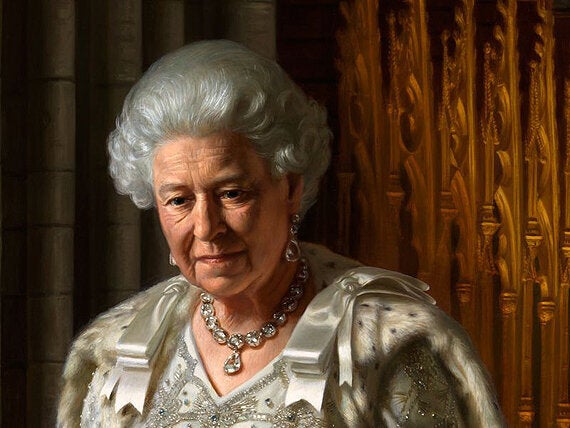
The Queen looks vacant in a detail from Ralph Heimans' portrait to mark the Jubilee
It is one of the longest roll-calls of artists in history and yet who among the 130-odd to try their hand has ever successfully captured a sense of who the Queen is?
Her portraits are invariably described as grim, steely, frosty, glum. Rarely has the royal sitter shown a smidgen of emotion.
When he painted her in 2001 Lucien Freud rather cruelly depicted her as sour-faced and puffy, with her carefully styled curls plumped up like a housewife's hair rollers and a mannish five o'clock shadow decorating her chin and mouth.
Perhaps the greatest British portrait painter of his generation was frustrated, having not been offered even a sliver of depth by this little old lady - indifferent to his reputation.
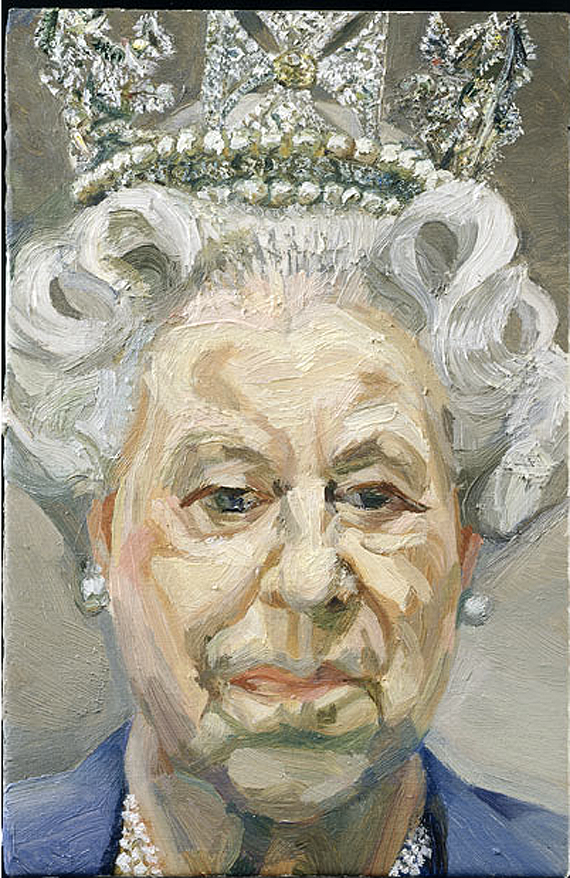
Lucien Freud's cruel 2001 portrait
Others have tried grandmotherly (Rolf Harris), glamorous (Sir William Dargie), ghostly (Robert Wraith) and stern (Sergei Pavlenko and Rupert Alexander).
But even harking back to Pietro Annigoni's classic and much-loved portrait of 1955, not a single one displays any great sense of feeling or expression.
And her refusal to give the baying public a bit of what it wants, i.e. a human side, has led to criticism she is distant and cold. In fact photos of her smiling on the royal barge during the Jubilee made front page headlines.
The papers eagerly try to find something different to say about each year's new offering, searching in vain for some twinkling of light behind the Crinoline mask.

Pietro Annigoni's 1955 painting is regarded as a masterpiece, but still... no emotion
But ultimately this quest is reduced to the bare bones - whether it is liked or not!
Australian artist Ralph Heimans is the latest to set out to capture that elusive beast - the Queen's personality.
The fact three-quarters of his huge 9ft by 11ft painting (part photo-realist, part stylised kitsch) is backdrop is the first indication that perhaps his quarry was not having it.
In fact Queen Elizabeth II sat for him for just an hour, in which he took some photographs and commented that she showed "a degree of thoughtfulness of expression".
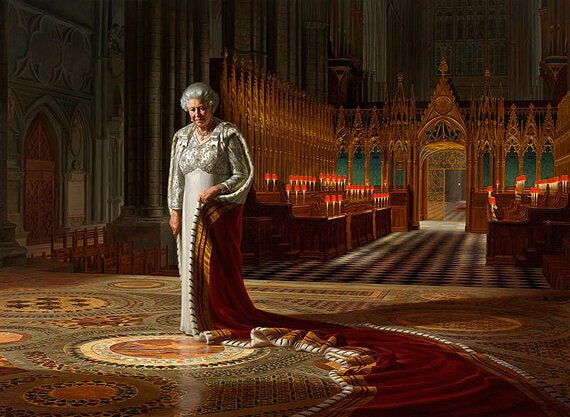
Heimans' huge 9ft by 11ft work is set in Westminster Abbey
With touching naiveté the 42-year-old described her as "incredibly vulnerable", perhaps not clocking the armed security detachment shuffling tiredly behind the brocade curtains of the drawing room.
Does the Queen actually show vulnerability in this, the latest effort at nailing her down?
Or is it more the case that by dwarfing her under the imposing architecture of Westminster Abbey a fabricated sense of vulnerability is suggested.
The painting itself looks like a gigantic book plate from a 1950s encyclopaedia or the front of a 1,500 piece jigsaw puzzle box.
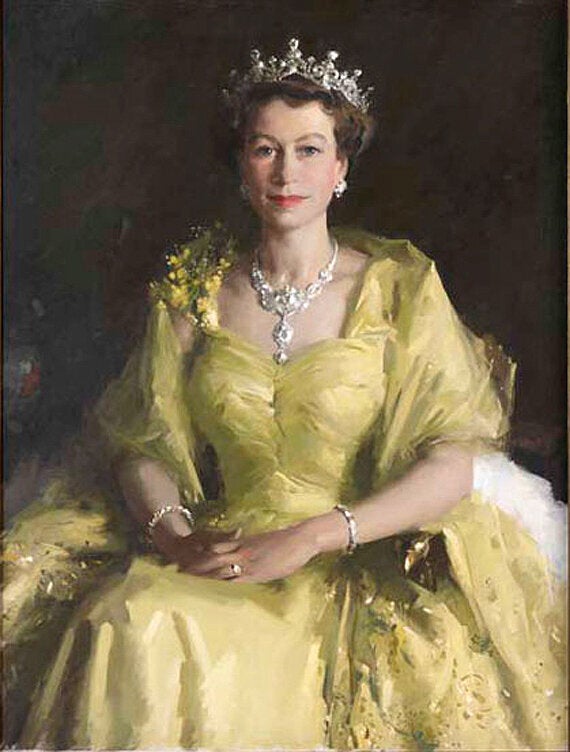
Sir William Dargie's beautiful but sublime 1954 portrait of the young queen
Certain colours are picked out and over-emphasised. The most beautiful aspect of it, the intricate detail of the Cosmati pavement in the foreground, is set, rather unfortunately, against a strobing mid-section of black and white tiles.
It's a fustily traditional work and in a way a bit of a sad picture, conveying a sense of abandonment, the last royal standing.
Heimans wants us to reflect on the Queen's life of dedicated service to her country, but it's hard not to also see it as a life that is very much about the past and perhaps out of synch with the changing world.
Elizabeth stands on the spot where she was crowned 60 years before. She is alone in the Sacrarium of the abbey, no crowds, just her memories.
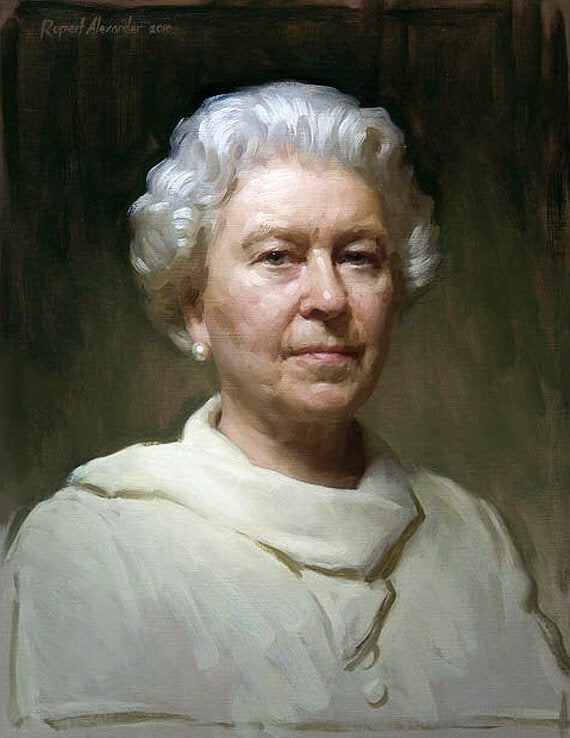
Rupert Alexander's 2010 painting portrayed a Queen in no mood for anything really
But what memories in this empty hall, what emotions?
We can only guess. Her face remains resolutely impassive, almost vacant of expression. And this in itself, among the Heimans' snapshots, is given a wholly new context in the setting he has painted about her.
The London-based artist commented: "By representing the Queen as she reflects on this incredible milestone in her life, I wanted to explore the dynamic between her public role and the personal, emotional dimension."
I'm afraid it will take more than a fancy set-piece to crack that nut.
Like Freud before him, Annie Leibovitz with her dark photographic take, or the purpling rigamortis skin of Antony Williams' 1996 effort, this painting, like all before, fails to tell us anything meaningful about the monarch.
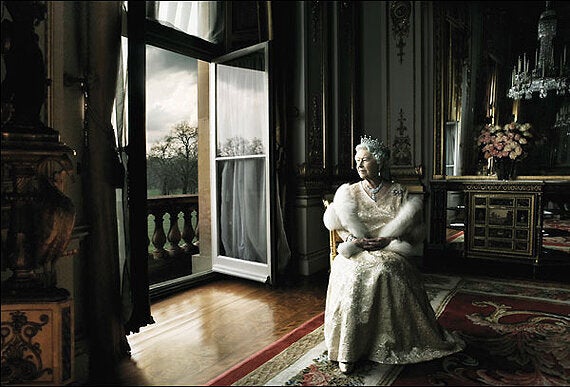
A dark, foreboding theme permeated Annie Leibovitz's 2007 series of portraits
In Australia, where the work is currently on display as part of the Jubilee celebrations, there is a more nostalgic sense of reverence for the Queen.
The Oz press gains no mileage criticising her, and instead sticks to the portrayal of HRH as the rock in a sea of (as Spinal Tap might have it) retarded royal adolescence - qualities displayed by everyone from the Duke of Edinburgh to Prince Harry and the naked Duchess.
But in Britain that reverence isn't quite as palpable, and the curious desire for the Queen to be more like the rest of us remains a tantalisingly unobtainable aspiration of the masses.
For now she remains, as she always has done, grand and unknowable, as inscrutable as a botoxed brow or the moods of the Golden Setter.
